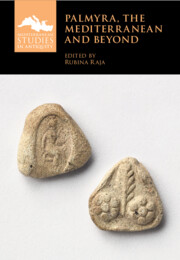
-
Select format
-
- Publisher:
- Cambridge University Press
- Publication date:
- October 2025
- October 2025
- ISBN:
- 9781009532044
- 9781009532082
- Dimensions:
- (244 x 170 mm)
- Weight & Pages:
- 0.623kg, 252 Pages
- Dimensions:
- Weight & Pages:
- Subjects:
- Ancient History, Classical Studies, Classical Archaeology
You may already have access via personal or institutional login- Subjects:
- Ancient History, Classical Studies, Classical Archaeology
Book description
Palmyra is one of the most famous sites of the ancient world and played a major role in the overland trade between the Mediterranean and the East. This volume explores fascinating aspects of Palmyrene archaeology and history that underline the site's dynamic relations with the Roman world, whilst simultaneously acknowledging its extremely local nature. The chapters explore Palmyra as a site, but also Palmyrene society both at home and abroad – as travellers in the then known world and contractors and businesspeople as well as innovative political and military leaders of their time. They illuminate Palmyra's and Palmyrene society's negotiations, struggles, benefits and disadvantages from being part of the Roman Empire, situated on the fringes between the East and the West, and their use of this location to recreate themselves as a central power player – at least for a time – within a rapidly changing world.
Contents
Metrics
Full text views
Full text views help Loading metrics...
Loading metrics...
* Views captured on Cambridge Core between #date#. This data will be updated every 24 hours.
Usage data cannot currently be displayed.
Accessibility standard: WCAG 2.1 AA
Why this information is here
This section outlines the accessibility features of this content - including support for screen readers, full keyboard navigation and high-contrast display options. This may not be relevant for you.
Accessibility Information
The PDF of this book complies with version 2.1 of the Web Content Accessibility Guidelines (WCAG), covering newer accessibility requirements and improved user experiences and achieves the intermediate (AA) level of WCAG compliance, covering a wider range of accessibility requirements.
Content Navigation
Table of contents navigation
Allows you to navigate directly to chapters, sections, or non‐text items through a linked table of contents, reducing the need for extensive scrolling.
Index navigation
Provides an interactive index, letting you go straight to where a term or subject appears in the text without manual searching.
Reading Order and Textual Equivalents
Single logical reading order
You will encounter all content (including footnotes, captions, etc.) in a clear, sequential flow, making it easier to follow with assistive tools like screen readers.
Short alternative textual descriptions
You get concise descriptions (for images, charts, or media clips), ensuring you do not miss crucial information when visual or audio elements are not accessible.
Full alternative textual descriptions
You get more than just short alt text: you have comprehensive text equivalents, transcripts, captions, or audio descriptions for substantial non‐text content, which is especially helpful for complex visuals or multimedia.
Visual Accessibility
Use of colour is not sole means of conveying information
You will still understand key ideas or prompts without relying solely on colour, which is especially helpful if you have colour vision deficiencies.
Structural and Technical Features
ARIA roles provided
You gain clarity from ARIA (Accessible Rich Internet Applications) roles and attributes, as they help assistive technologies interpret how each part of the content functions.

